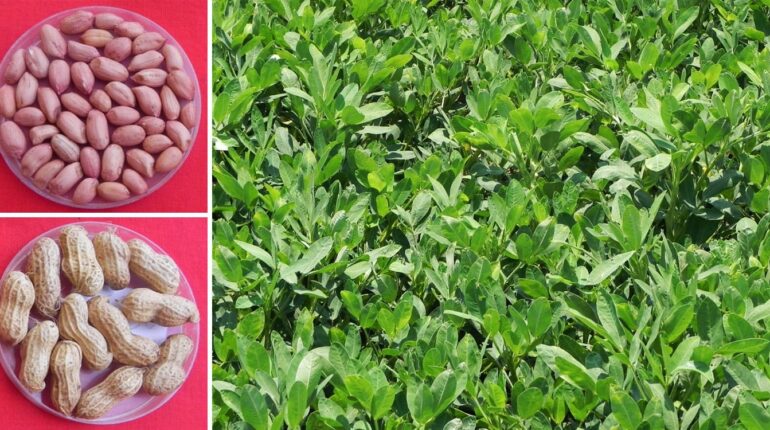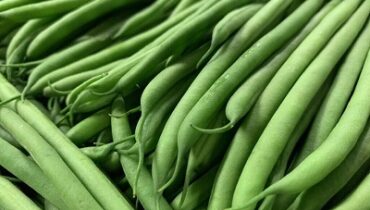Peanuts are referred to as “groundnuts” in Kenya, and are locally known as “Njugu Karanga” (Swahili). Groundnuts are mostly farmed for food and sale by small-scale farmers in western Kenya. This region has a tropical environment that is ideal for agricultural.
Read also:How To Make Money Through Farming In Kenya.
In Kenya, there are two primary types of peanuts:
The runner type and the bunch type are two different types of runners (Red Valencia).
Bunch types are smaller, tastier, and more marketable than other varieties. It takes 60–75 days to reach full maturity. The runner is a bigger type with higher yields; it matures in 90–100 days.
Groundnuts are a high-protein, high-edible-oil crop that adds nitrogen to the soil and can be cultivated on low soils. They work on the farm for a shorter period of time and have a large market in Kenya. Groundnuts are high in monounsaturated and polyunsaturated fats, which are good for your heart. Children, vegans, and those who are protein deficient should include high protein foods in their diets on a regular basis. They also have significant levels of the antioxidant polyphenols, which prevent infection by inhibiting the formation of free radicals.
Groundnuts can be eaten in a variety of ways, including:
- Groundnuts can be eaten in a variety of ways, including:
- The groundnut is eaten Raw
- Roasting groundnuts is an option.
- It is possible to blanch groundnuts.
- Peanut butter can be prepared from groundnuts.
Read also:How To Start A Profitable Rabbit Farming Business In Kenya
Groundnuts can be crushed and combined with traditional dishes, or they can be cooked on their own as a source of protein.
Groundnut Health Benefits
The following are some of the advantages of groundnuts:
Groundnuts are a fantastic source of cooking oil.
• Animal feed is typically made from groundnut cake.
• Groundnuts are primarily farmed as a staple food by family farmers.
• You may make money by selling groundnuts.
• Proteins, energy, fats, and minerals are abundant in groundnuts.
Growth-friendly conditions
Groundnuts thrive in warm climates below 1500 meters above sea level, where temperatures range from 28 to 30 degrees Celsius. Their flowering and seed production are affected by low temperatures. They also require 500 to 600 mm of rain during the course of the growth season. The crop can withstand dryness and poor rainfall, but yields will be modest. Although the crop can grow on clay soils, it requires well-drained soils.
Sowing
Planting dates are determined by the amount of rainfall in the area and the length of the crop season. To ensure successful germination, the soil moisture must be sufficient. Seeds should not be planted right after heavy rains since they absorb too much water and rot. Excessive soil compaction occurs as a result, which may stifle germination. Early sowing enhances yields and seed quality in general (a considerable delay in sowing might cut output by 50%).
Seeds should be planted 5–6 cm deep. To ensure uniform sowing depth, germination, and crop stand, a 5–6 cm deep groove should be cut along the rows for planting, and once the seed has been planted at the proper depth and spacing, the soil should be pressed down to ensure good contact with the seeds, allowing them to extract moisture more effectively.
It is critical to spread groundnut seed in rows and at the proper spacing in order to achieve the following results:
Reduced rosette disease incidence enables more consistent pod maturity, higher-quality seed, and higher yield.
Individual groundnut plants produce fewer pods when planted closer together, but only for a brief period of time. Overall, this will ensure that the pods are of similar age and development stage, making it easy to determine when to harvest. There will be lower yields per hectare if the spacing is wider.
Spacing
Groundnuts are grown on a large scale.
The spacing is determined by the growth behavior and variety. The spacing between rows and plants for small seeded Spanish types (bunch) is 30-45 cm between rows and 7.5-10 cm between plants. This results in a plant population of 167,000 plants per acre. The large-seeded Virginia kinds (runners) are spaced 60 cm between rows and 10-15 cm between stations, resulting in an optimal plant population of 89,000 plants per hectare. Plant populations can reach 250,000 plants per hectare when irrigated. This is dependent on a number of factors, including seed quality and planting density. Individual seeds are placed 3-5 cm deep when hand sowing is used.
Kenyan groundnut farming
Rotation of crops
Crop rotation that is well-planned can result in high-quality crops. Groundnuts should be cultivated in rotation with other crops such as maize to lessen risk in the farming system.
Groundnut should not be planted constantly on the same area to avoid pests and diseases accumulating. A three-year rotation or longer usually minimizes disease load.
Pest and disease control
Groundnuts are sensitive to a variety of diseases and pests, resulting in lower yield and quality.
The majority of infections are caused by fungi, viruses, or bacteria. Rosette, early leaf spot, late leaf spot, and rusts are the most common diseases. The devastating pests are aphids, leafminers, thrips, termites, and beetles.
Insecticide spraying, timely cropping and harvesting, intercropping, field sanitation, planting resistant types, and adequate storage are all suggestions.
Pests
The bulk of groundnut insect pests can be classified as follows:
Insects that live in the soil (such as termites, white grubs, earwigs, and subterranean ants); insects that feed on the foliage (such as leaf miners, caterpillars, armyworms, and bollworms); insects that transmit viral diseases (thrips, aphids); and insects that damage flowers and growing parts (such as thrips, aphids) (blister beetle). Termites, aphids, thrips, and leaf miners are the most common pests.
Harvesting
It’s crucial to know when to harvest groundnuts. A farmer must scan his garden on a regular basis because they can be flowering even during harvest. In sandy and loam soils, hand pulling is one of the most common and suitable methods, while ox-drawn ploughs or hoeing can be utilized when dryness strikes during harvest.
Aflatoxin contamination can result from pod damage, thus it’s best to avoid it. When molds enter damaged pods, aflatoxins are produced. When drying takes place on bare ground, the issue becomes even worse. Aflatoxin can also be found in pods that have not been properly dried.
Commercial farmers are recommended to measure moisture content since aflatoxins are becoming a big health risk.
Methods of harvesting
Lifting by hand
In sandy, well-drained loam soils, harvesting by hand is preferable for the bunch/erect groundnut cultivars. It’s significantly more difficult to pull off the entire plant without losing pods whether the soil is wet and heavy or very dry.
Lifting by hand with a hoe or fork
It is feasible to move plants out of heavy or dry soil with less pod loss by using a hoe during harvesting. Spreading/runner varieties are also easier to lift. It’s important not to injure the pods with the hoe, as this puts them vulnerable to fungal attack. The use of a hoe fork reduces the risk of such harm.
Cleaning
After lifting the plant, shake it to remove any excess soil from the pods, especially if the soil is damp or heavy. Longer drying durations and better circumstances for the establishment of undesirable fungal growth will result from soil adhered to the pods.



